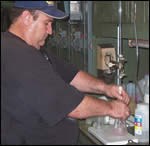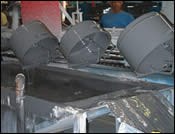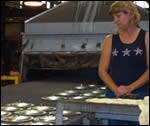Clean Finish
Cleaning chemistry change provides multiple benefits
At Columbian Home Products, they value history. But that’s to be expected from a company with roots going back more than 130 years.
The manufacturer of enameled steel cookware products got it start in the early 1870s as the Bellaire (OH) Stamping Co. After catastrophic fires in Bellaire and at a second plant in Harvey, IL, the company put down roots—and put up a sprinkler system for fire protection—at its current location in Terre Haute, IN, in 1902.
The Terre Haute facility, all 600,000 sq ft of it, was built using the state-of-the-art manufacturing technology of the time. In addition to the sprinkler system, the company drew its own water from deep wells, had its own sewage treatment facility and used boilers to provide steam power for production operations and to generate electricity from its stable of four generators. Buildings were built in the foundry style, with high bay windows that provided sunlight and could be opened in warm weather.
Products
Chances are good you’ve used or at least seen products manufactured in this plant. The company makes Graniteware porcelain enameled steel cookware such as roasters, stockpots, canners and other pieces. “Shapes” are stamped from either 0.018-inch thick cold-rolled steel or a thinner steel called “tin plate,” then coated with 6 mils/side of enamel. Most items sell for just a few dollars through such retail giants as Walmart, K-Mart, Kohl’s and Target.
The cookware tends to inspire fierce loyalty in many consumers. There are Graniteware collector’s groups around the country. One of the groups recently held its annual convention in Terre Haute and received a tour of the plant. Books have been written to guide collectors in pursuit of highly sought-after pieces.
Columbian also exports products to several countries, including Greece, Iceland and France. “Our products are very popular in those countries because they’re American-made,” Operations Manager Bill Carper explains.
And the company continues to innovate in product design. An example is a patent-pending roaster that nests to facilitate stacking for retail sale and minimizes storage space needed at home
Old or new, all the cookware products are made on vintage equipment using processes that are decades old. Columbian’s oldest operating stamping press dates to 1917; the newest, a 400-ton, four-station transfer press, was installed in 1982. Ongoing maintenance and a continuous improvement attitude allow the older equipment to perform some operations that might not be practical on newer machines , plant personnel say. The company is a union shop, and average seniority of the roughly 120 workers in the facility is near 30 years.
Energy Cost Cuts
So how has Columbian managed to stay in business competing against suppliers from low-labor-cost countries? “We provide a good-quality product at a very reasonable price,” says Carper. “Our products are very practical and used often, and at the same time their quality has stood the test of time. I inherited a canner from my mother that was made here, and her mother and grandmother also used products that were made here.”
At the same time, the company is always looking for process improvement opportunities, especially those that can lower costs. A few years ago, Carper and Plant Engineer Ron Wingerter attended a lean manufacturing workshop. The two realized that many of the lean principles they had just learned about were simply not applicable in Columbian’s facility.
“We came out of there knowing that our processes were not set up to operate in a lean configuration even though we have high efficiencies in many operations,” Carper recalls. “So we asked, ‘Where are the opportunities for us?’”
They decided that trying to reduce energy consumption for both process and building heating was an area that was ripe for exploration. “Natural gas prices back then were $2.30 a decatherm, but 60% of the natural gas we were consuming over the course of the year was used for building heat,” Carper says. “So we focused first on reducing that, and over the last four years we’ve actually cut our overall natural gas consumption by about 40%.”
Most of the reduction was made possible by reconfiguring boiler operation and by recycling process heat from the kilns used to fire porcelain enameled products at temperatures of 1,530°F. Ductwork now captures clean heat from the kilns and sends it to most areas of the plant. “As far as building heat, it’s really the weekends, when we’re down, that we have to use steam to keep things heated,” Wingerter says. The company operates four, nine-hour shifts per week.
The changes enabled Columbian to idle one of its two, 750-hp boilers throughout the winter of 2006-2007. “We think we can probably get by with about 350 hp maximum, and our goal is to eliminate steam use altogether in the summer,” Carper says.
Focus on Cleaning
Wingerter says the next logical target for reduced energy consumption was the plant’s parts cleaning system, which handles up to 40,000 pieces per day to feed four enameling lines. “The cleaning line was fairly obvious,” he recalls. “After we reduced our steam usage for plant heating we started looking at other areas where we used a lot of steam. On the cleaning line, we use process heat all year long. We just knew there had to be a way to cut that cost.”
Consisting of four cleaning tanks, three rinse tanks and a dryer section, the conveyorized cleaning system uses 32 spray nozzles in each tank—16 top and 16 bottom—operating at pressure of 10 and 2 psi, respectively. The line was designed primarily to handle the soap-based compound used as a lubricant in Columbian’s stamping operations. It’s a proprietary formulation containing, among other ingredients, Murphy’s Oil Soap, and its makeup was part of the reason the cleaning line operated at an elevated temperature.
“We injected live steam at 180°F into all the tanks,” Wingerter says. “The reason we had to keep the temperature so high is because of the drawing compound we use on the steel. It consists of synthetic soap and Murphy’s oil soap among other things.
“When you rinse that off, you get a lot of foaming, so basically we had to keep cleaning and rinse temperature that high or the foam would pour out of the tanks. If something happened to the steam and the temperature in the tanks dropped, we’d have more foam than we could contain.”
Columbian began working with Benchmark Products (Indianapolis, IN), supplier of the current cleaning chemistry, to develop an improved cleaning process. According to Benchmark’s Mike Turley, foaming problems were the result of using a cleaning chemistry with too high a cloud point—the temperature at which the constituents of a mixture start to separate into different phases.
“The cloud point on the cleaner they were using was about 175°F, and they were running at 180°F,” he explains, “so the chemistry didn’t really have any kind of defoaming power.
Turley began experimenting in Benchmark’s lab. “We kept the same basic cleaner and took out some of the water softeners, because the water was soft enough and because water softeners generate foam,” he recalls. “That lowered the total solids in the cleaner, which lowers the cloud point. We also lowered the alkalinity. The old cleaner was about 24% potassium hydroxide, and we took it down to about a third of that. They didn’t need that much alkalinity and it cost more to neutralize, so we tried to save them money on disposal as well.
“We also began experimenting with different surfactants. Eventually, we found two that seemed to work synergistically to really hold down the foam. And they were already using one of them, so it wouldn’t affect the enameling process.”
After successful lab trials, Columbian’s cleaning line was charged with the new chemistry during a planned summer shutdown. Workers also installed new steam valves. Function of the old ones was suspect at best—they had never been shut off!
Low-Temp Process
The cleaning process now consists of a very low-concentration prewash followed by 3% concentration of cleaner in three tanks with tank 4 counterflowing to tank 1. Cleaning is followed by three rinse tanks—two with water and a third with a rust preventative for parts that will be stored for up to three days before enameling.
The cloud point of the new cleaning chemistry is 90°F. Columbian began by lowering tank temperatures to 150°F—a substantial cushion before foaming might become an issue. Since then the steam has been completely shut off in the cleaning tanks, but process temperature in those tanks is still holding at about 140°F.
“The process is staying hot with no steam added to the cleaning section,” says Cleaning Group Leader Brian Walker. “We think it’s a combination of the way the cleaning line is insulated, the fine sprays, and heat from the pumps that’s working to maintain temperature in the cleaning tanks.”
“But winter temperatures might be interesting,” Wingerter says. “We’ll just have to see if we need to add steam heat to the cleaning tanks when things are cooler. We won’t turn the steam on unless we have to.”
According to Walker, the new cleaning process is easy to control. “We titrate the solution every two hours to make sure it’s maintained at 3%, and additions are made by timer to Tank 2 from a 300-gal holding tank containing 18% cleaning solution,” he says.
The new, lower-solids chemistry has also reduced maintenance on the cleaning line, Walker adds. “It seems to keep the equipment cleaner. Each tank has two stainless steel wire mesh screen filters that are cleaned every day, but they are cleaner than they used to be. The really fine spray nozzles we use don’t plug as much, and we haven’t cleaned the tank walls since we began using the new cleaning solution.”
Steam is still used to hold temperature in the rinse tanks at 150°F to assure parts come out of the dryer ready for enameling. “The pieces have to come out dry,” Wingerter says. “If we send parts to the enameling line with too much water on them, the enamel will run. We’re experimenting to see how low we can go on the rinse tank temperature and still be able to dry parts in the dryer section.”
Walker is working on slowly lowering temperature in the rinse tanks and expects to be able to wring a bit more savings from the process. But the dryers are the next target for energy cost savings, he says. “We’re working on finding an alternative to the steam-heated dryers, which run at 220°F.”
Wingerter says the cleaning line project is a good example of the kind of thinking that has enabled Columbian to survive and thrive for more than 100 years, even against low-cost import competition. “Even though we’ve been doing essentially the same thing for 100 years, there are always processes that can be improved—especially from a cost standpoint,” he says. “Competition is so intense right now that you’d better be looking for ways to improve and cut costs or you won’t be around in a year or two.”
Related Content
Concrete Reinforced Bars Built to Last
Not all corrosion-resistant materials for infrastructure are created equally. Epoxy-coated steel rebar has advantages that other materials used to prevent corrosion do not.
Read MoreMix of Automation and Skilled Employees Generates Quality
This Pennsylvania plating company’s general manager shares insights about being recognized as a Top Shop for several consecutive years as well as his thoughts about automation, customer service, hiring skilled workers, the challenges of installing a new line and more.
Read MoreShedding Light on Surface Inspection
State-of-the-art reflector-based lighting system improves luminosity and ergonomics for surface inspection tasks while reducing energy usage.
Read MoreCuring Oven Basics
Simply heating up the substrate does not cure the coating. There are many variables to consider when choosing the best cure oven for your application...
Read MoreRead Next
Episode 45: An Interview with Chandler Mancuso, MacDermid Envio Solutions
Chandler Mancuso, technical director with MacDermid Envio discusses updating your wastewater treatment system and implementing materials recycling solutions to increase efficiencies, control costs and reduce environmental impact.
Read MoreDelivering Increased Benefits to Greenhouse Films
Baystar's Borstar technology is helping customers deliver better, more reliable production methods to greenhouse agriculture.
Read MoreA ‘Clean’ Agenda Offers Unique Presentations in Chicago
The 2024 Parts Cleaning Conference, co-located with the International Manufacturing Technology Show, includes presentations by several speakers who are new to the conference and topics that have not been covered in past editions of this event.
Read More


























